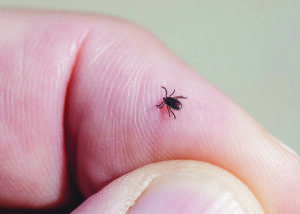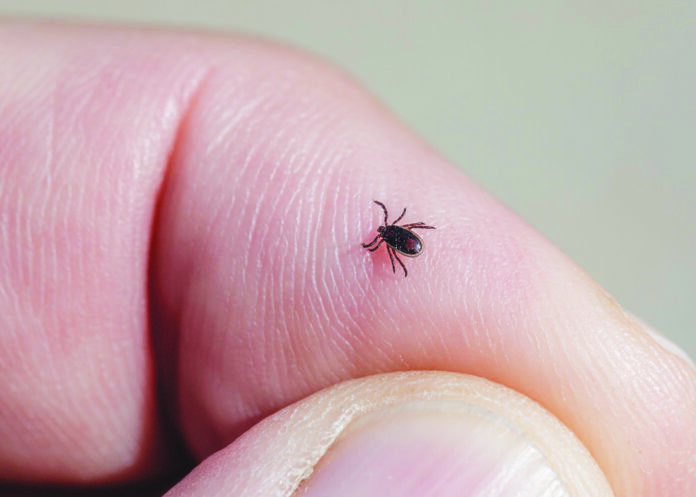BY CAROL VAUGHN, Eastern Shore Post —
Eastern Shore residents should take tick bites seriously and consider tick-borne disease as a possible cause of symptoms, according to an expert.
The advice comes after recent reports of serious illness, including a hospitalization and a probable death here resulting from a lesser-known tick-borne disease, babesiosis.
Some tick-borne diseases, including erlichiosis and babesiosis, can be fatal if not treated.
“People are so casual” on the Shore about ticks, said Harborton resident Ellen Stromdahl.
Stromdahl’s mission is to raise awareness, including in the medical community, after an aquaintance’s close call.
Stromdahl, an entomologist who authored more than 20 peer-reviewed articles on ticks and tick-borne diseases, until her recent retirement led the Department of Defense Human Tick Test Kit Program (MILTICK) of the Defense Centers for Public Health at Aberdeen Proving Ground in Maryland.
The program identifies and tests ticks removed from Department of Defense personnel and is one of the largest, longest-running tick surveillance programs in the nation.
Stromdahl currently serves on the Virginia Legislative Tick-Borne Disease Work Group, charged with making recommendations by Nov. 1 to state officials for reducing the occurrence and impact of tick-borne diseases.
Hotspot for detection
Virginia’s Eastern Shore is a hotspot for detection of the tick-borne parasite that causes babesiosis, according to the group’s draft report.
Three-quarters of positive ticks collected beween 2010 and 2017 from 18 locations were found at Kiptopeke State Park, the report says.
“The Virginia Eastern Shore is also the hotspot for locally acquired human cases of babesiosis, and the Maryland Eastern Shore is the location of the first locally-acquired case in that state … so it is important that medical practitioners on the Delmarva Peninsula are aware of the presence of this pathogen in the area,” according to the report.
Stromdahl in June was attending a dinner party at a friend’s house when a guest fainted. The guest was treated by EMTs and later went home, feeling somewhat better.
Still, in the next days, his illness worsened markedly.
Doctors did not at first identify tick-borne disease as the cause of the senior citizen’s symptoms, according to Stromdahl.
“They were thinking heart, organs — not an infectious disease at all. No one asked him if he had been bitten by a tick,” she said, adding, “That should be a triage question.”
When the man’s wife took him to the emergency room at a Norfolk hospital, he was admitted to the intensive care unit.
The diagnosis was babesiosis, which is not as familiar to Shore residents as other tick-borne diseases such as Lyme or acquired red meat allergy.
A simple tick-borne disease panel would have identified the illness, according to Stromdahl.
Fortunately, he recovered, but only after extensive treatment.
First identified in Accomack
Locally transmitted babesiosis was first identified in Virginia in 2016, in Accomack County, with additional cases identified in Northern Virginia in 2020 and in the Southwest Highlands from 2021 to 2022.
The numbers are relatively low: two confirmed cases and one probable case in Accomack and one probable case in Northampton since 2016, according to Virginia Department of Health data.
Still, it is important to consider a tick bite as a possible cause of symptoms — especially considering that it could lead to severe illness and even death if disease is left untreated, Stromdahl said.
“No one has ever heard about (babesiosis),” she said, noting that until now, she worked mainly to educate people about ehrlichiosis, the symptoms of which include sudden onset fever, possibly accompanied by severe headache, muscle pain, nausea and vomiting, rash, and confusion.
With ehrlichiosis, antibiotics should be given as soon as possible to reduce the risk of severe or fatal illness, according to a Virginia Department of Health publication.
Now, babesiosis also “is here” and “has taken people by surprise,” Stromdahl said.
Babesiosis, unlike ehrlichiosis and some other tick diseases, is parasitic. Symptoms can begin as early as one week after a tick bite, but typically develop within a few weeks to months after.
Many cases are asymptomatic, but people may experience fever, chills, muscle pain, joint pain, fatigue, and jaundice, according to the VDH. Severe cases can include anemia and thrombocytopenia, a deficiency of platelets in the blood.
“The parasites seem to really go for the red blood cells of older people,” Stromdahl said, noting that, according to data, older men appear to have had more severe cases.
Doctors’ first thoughts in diagnosing older people with symptoms might not be a tick-borne disease. That’s something Stromdahl is working to change.
“You can be cured, but you’ve got to realize what it is and get the correct medicine,” she said, adding that doxycycline, an antibiotic used to treat other tick diseases, does not cure babesiosis.
Additionally, the deer ticks that carry babesiosis also can carry Lyme disease — meaning both may need to be identified and treated in a single patient.
More deer, more ticks
The proliferation of deer on the Shore means deer ticks also are proliferating.
Accomack County Supervisor Ron Wolff invited a health department official to speak to the Board of Supervisors about tick-borne diseases in September.
Wollf said, “One of my longest and closest friends on the Eastern Shore that I’ve known ever since 1975, when I moved here, was bitten by a tick and died in less than a month’s time,” he said.
A test of blood the man had donated showed he had contracted babesiosis.
“That was in the middle of June. He died Aug. 9 — that quick,” Wolff said.
The health department provides education on tick-borne illness and prevention, according to Jon Richardson, Eastern Shore Health District Director. The health district has available a brochure on tick-borne diseases in Virginia.
“We use social media and our outreach workers for education in addition to the brochures. … Our MRC (Medical Reserve Corps) volunteers also provide education at public events including handing out tick removal kits, which contain tweezers, alcohol, and a bandaid, and weblinks to information on tick-borne illnesses and prevention,” he wrote in an email to the Post.
Richardson advised people walking in woody or overgrown areas to “wear long pants, tucked into socks, and long sleeves … and treat your clothing with permethrin or other repellant. Wearing light-colored clothing makes it easier to see ticks and remove them before they can bite.
“Anytime someone is in an environment where ticks may be present it is important to conduct a tick check periodically while there and then a thorough one once you have left the area, including showering with soap and water.
“Ticks should be removed immediately when found, using tweezers and grasping them near the mouth as close to skin as possible ensuring no part of the tick is left behind.
“Care should be taken not to rupture the tick’s abdomen during removal. Once removed, the site should be washed with soap and water and then apply antiseptic to the bite area.
“The tick should be saved in a plastic bag in the event illness from the bite occurs, as the tick ID may help the doctor diagnose the illness.
“If you become ill and have been exposed to ticks, you should let your doctor know and consult with them on next steps,” Richardson said.



